Why the tomato is this small-scale farmer’s greatest success
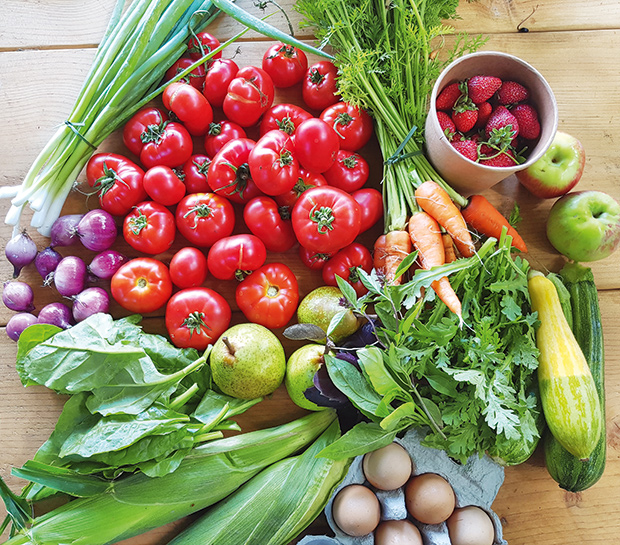
Angela Clifford shares wisdom from her family’s organic, permaculture-based, self-sufficient small farm.
Words and photos: Angela Clifford
Who: Angela Clifford, Nick Gill, Ruby, Flynn & Matilda
What: The Food Farm
Land: 6.5ha (16 acres)
Where: Amberley, 50km north of Christchurch
Social Media: @thefoodfarmnz / thefoodfarm.nz
I should start with a confession.
I’ve never been a fan of the term ‘lifestyle block’.
Instead, I’ve always embraced ‘small farm’ for a few reasons.
We’ve worked hard for this piece of land, giving up other things to buy it. If I’m being honest, the bank still owns most of it, although light has appeared at the end of that tunnel as I get older. Calling it a ‘lifestyle’ makes it seem less determined and much easier than it is.
We live in the wine region of Waipara Valley in North Canterbury. That’s in no small part due to a great deal of good fortune. We’ve come from the strong food and wine culture of South Australia (although I’m from Aotearoa originally) to a farm in Kai Tahu territory. It’s important to us to acknowledge that, and also that many of the original settlements were far from fair.
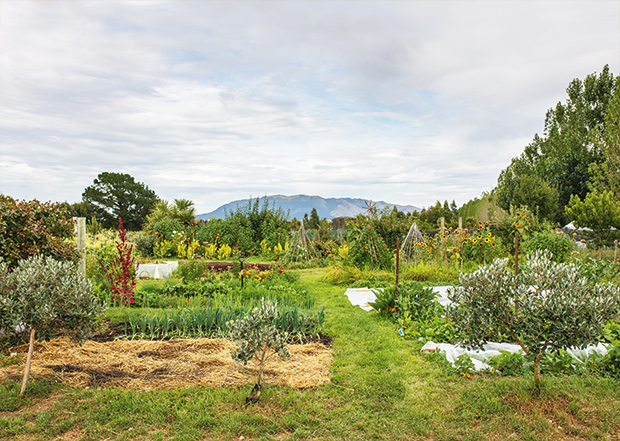
While my ancestry is more opaque, I’m the beneficiary of many generations of landowners, and I worry about my children and their access to land in the future.
Every day I’m grateful to be in this place. Since the Covid pandemic began, that thankfulness has multiplied exponentially. Every morning, I take a moment to acknowledge it, and it significantly affects what we do on our small farm.
To be part of the multitude of life on this 6.5ha feels important; small in the big scheme of things, but important nonetheless. I feel a daily responsibility to do three things:
• increase the biodiversity of our farm;
• grow food to feed ourselves;
• contribute to our community by teaching others how to do the same.
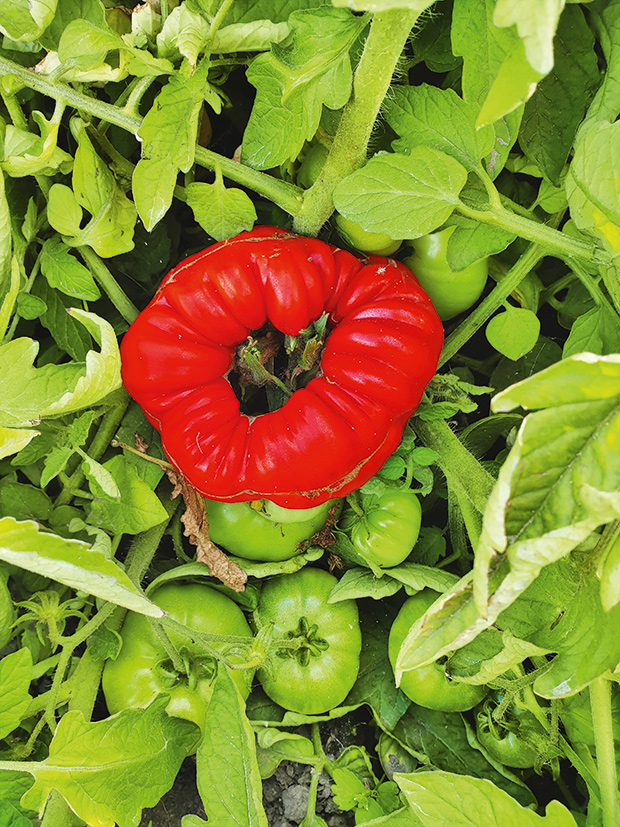
I believe proper food resilience is only achieved when those around us have access to good food too. Community sufficiency is our goal rather than personal self-sufficiency.
We’ve had 17 years of learning here, and the challenges have been as prolific as the triumphs over 68 seasons. We’ve shared them with well over 300 wwoofers (volunteers who work on organic properties) from all over the world. They’ve all left a recipe with us, a small part of their culture crafted into something delicious.
Permaculture has been our scaffold, our guiding pathway for learning and understanding throughout that time. The ability to see the world in systems has been a huge advantage in all aspects of my life.
OUR GREATEST SUCCESS
It’s a tomato. Like all the best things, the success of this tomato doesn’t even really belong to us. Most likely, it has been grown in our region for over 100 years. For most of that time, NZ-grown field tomatoes outcompeted imported canned ones. This one survived because it was a bush tomato and didn’t need staking. That meant it could happily endure Canterbury’s infamous, strong nor’ west winds.
It was known as the ‘South Australian Dwarf’, saved by Judy Grigor’s family near Cheviot.
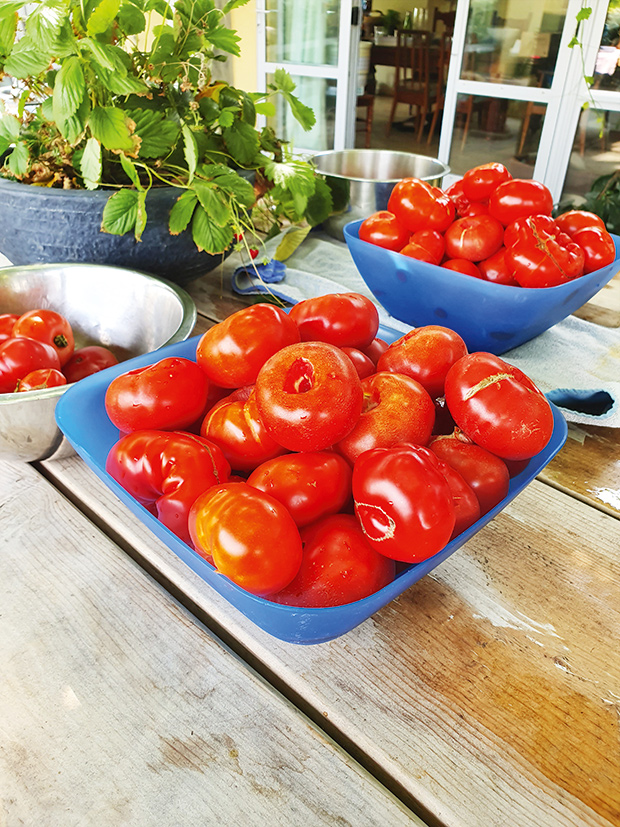
We make 200-300 litres of passata and still run out.
Its connection to South Australia – the place my husband calls home and where our eldest daughter Ruby was born – seemed like a good place to start when we first moved here. I suspect many other plant lovers have trees, flowers or vegetables they grow for sentimental reasons. The story of our journey here is woven into the seed every spring when we sow it.
The Cheviot tomato (as we’ve named it) is an heirloom vegetable. It’s a voluptuous beauty, a big weighty tomato at its best. The first flush tends to be doughnut-like with the calyx (where the fruit attaches to the stem) over-actively playing its role, as you can see in the picture at left.
But things quickly get sweeter, and each plant produces about 2kg of fruit, sometimes more. They’re perfectly acceptable to use as an everyday slicer, but that makes it sound so perfunctory. Where they really come into their own is as a processing tomato.
We make around 200-300 litres of passata from our Cheviot tomatoes every year. We use it as the base for pasta sauces, dahl, soups, bean casseroles, pizza sauce, and so much more. Even then, we have yet to make it through a year without having to resort to at least a few weeks of insipid, bitter, tasteless canned tomatoes. It seems the more we grow, the more we eat.
Making this passata is now a major part of our growing season. The rhythm of cleaning the bottles, picking the fruit, lighting the wood oven, washing, coring, and roasting the tomatoes is hundreds of now subconscious decisions and movements.
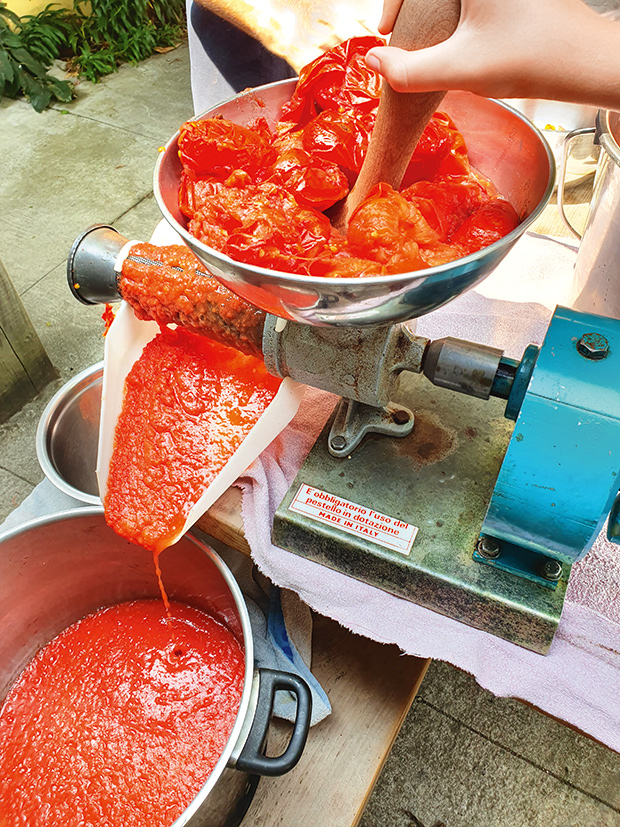
The heat defines the season at this time of year, so it’s an outside job, performed under the grapevine on the terrace, close to the wood oven.
Passata is differentiated from tomato paste or tomato sauce by its consistency. It’s thicker than sauce but not as thick as paste. It also has the skins and seeds removed as they both contribute to bitterness.
That can be tricky unless, like us, you’re lucky enough to have mechanical intervention.
I learned how to make passata from Rosa Matto and her nonna. Rosa hails from southern Italy but now resides in the leafy suburbs of Adelaide, where she runs a cooking school. In her community, making passata is a significant ritual. The sauce is cooked up in empty Coopers Brewery long neck beer bottles and stacked into drums in a hot water bath. A single large basil leaf is poked into the neck of each bottle. It’s a favourite in suburbs full of Greek and Italian immigrants. Even thinking about it evokes strong memories of food and community.
Here on The Food Farm, we’ve found our own methods and traditions, but we brought a vital piece of kit with us from Australia. It’s a spremipomodoro con ventosa or a tomato squeezer made by Super Gulliver. This hand-turned machine separates the skins and seeds from the pulp with incredible efficiency.
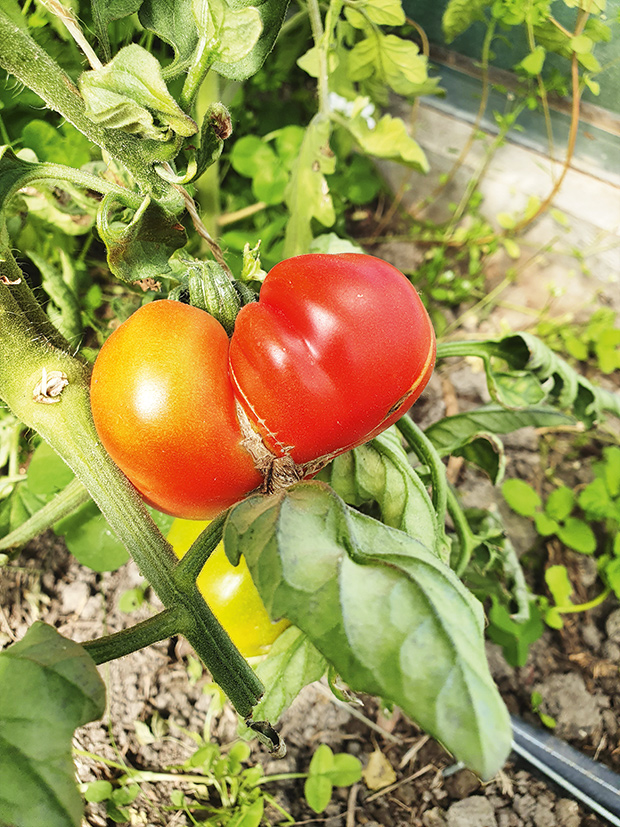
But our passata making went next level a couple of years ago. I’m friends with a wonderful man called Ian Thomas, who played a key role in establishing the Hawkes Bay Farmers’ Market. We’re kindred spirits in food.
He casually flicked me a photo of something extraordinary he’d spotted for sale on Facebook. The family of a Polish nonna were clearing out her garage and wanted to get rid of a squeezo, often called the original food and tomato mill.
I’d heard of these legendary machines but had given up hope of ever finding one. I can only imagine it came from her homeland with her as these incredibly well-built, very heavy mills aren’t the sort of thing you freight across the world via Amazon.
Ian offered to go and buy it for me and ship it south. Hand on heart, it’s the best $90 I’ve ever spent. The squeezo now effortlessly separates the pulp, and years of child-powered handle-turning is behind us. As a bonus, it also makes magnificent apple puree.
Passata-making is a worthy pursuit even if you don’t have a spremipomodoro or a squeezo. Just about every family has a mouli, which will efficiently separate the skins and seeds from the pulp. There’s probably fancy modern kitchen machines with attachments that can achieve the same outcome, but none have the same European authenticity and nonna stamp of approval.
Food Farm Passata
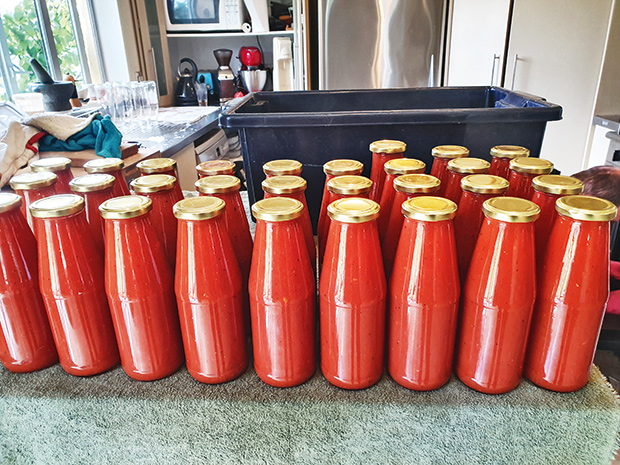
Time: 60 minutes
Makes: 750ml approximately
We roast our tomatoes to concentrate the flavours, but you can also cook them up on the stove.
INGREDIENTS
3kg tomatoes
6-8 garlic cloves
2 tsp salt
woody herbs such as thyme
olive oil
pepper
METHOD
Pre-heat the oven to 180°C. Prepare sterile bottles or jars.
Core the tomatoes and put them on a baking tray with the garlic cloves.
Drizzle with olive oil, sprinkle with salt and pepper and throw on a sprig or two of thyme (not basil because it will just burn).
Roast on high in the oven for around an hour, until significantly browned.
Drain in a sieve. The ‘tomato water’ collected at this point makes a delicious savoury drink or cocktail ingredient. Sometimes it sets like gel and can be used as a base for summer soups.
Put the drained tomatoes through any type of press, then put back into a pot and bring to the boil to prevent fermentation.
It’s super important to hot bottle the sauce as quickly as possible. You could also use the water-bath method or pressure can it instead.
This passata will store for up to a year in a cool, dark place. Check from time to time to ensure there’s no fermentation happening – if there is, discard those bottles.
ABOUT ANGELA
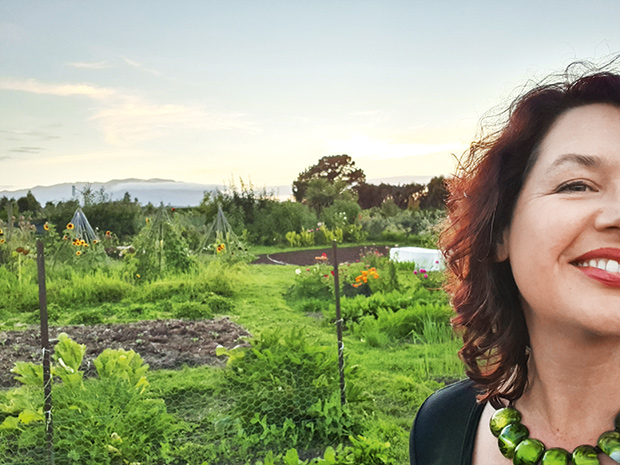
Angela Clifford and her family run an almost self-sufficient permaculture, no-dig garden and block, milk a house cow, and grow and process their own meat, including pigs and poultry. She’s also the CEO of Eat New Zealand, a not-for-profit collective of chefs, food producers, media, tourism, and event operators promoting the best NZ food, drink, and culinary tourism opportunities to the world.

